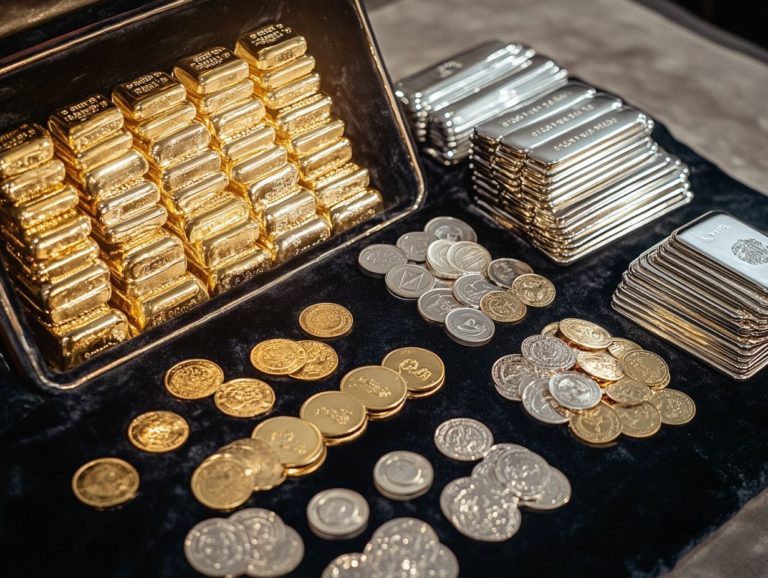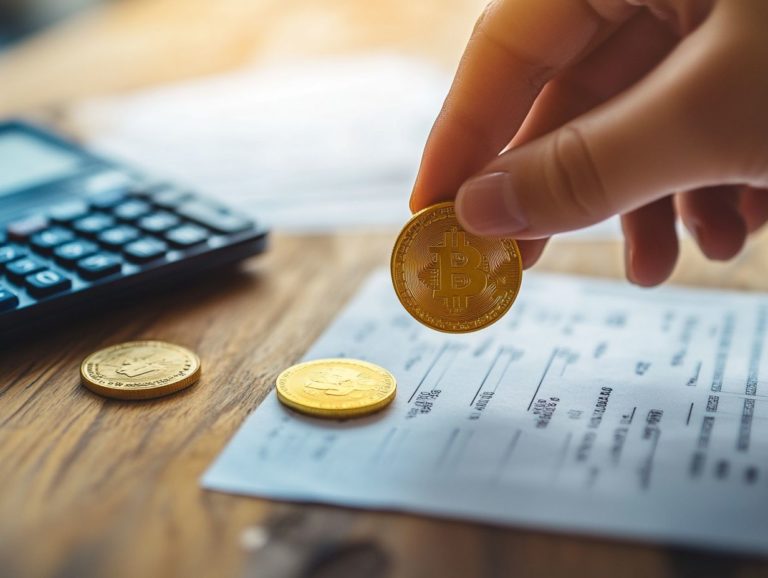What are the Benefits of Investing in Silver?
Investing in silver provides a unique combination of potential rewards and strategic advantages.
Whether you want to diversify your portfolio or protect against inflation, silver is a great choice.
You can invest in physical coins, bars, ETFs, or stocks, ensuring something for every investor.
Navigating the silver market requires attention to trends and security measures.
This article will guide you through the benefits and strategies to maximize your silver investments.
Contents
- Key Takeaways:
- Benefits of Investing in Silver
- Types of Silver Investments
- Factors to Consider Before Investing in Silver
- Maximizing Returns from Silver Investments
- Frequently Asked Questions
- What are the Benefits of Investing in Silver?
- What are the potential returns on investing in silver?
- How does investing in silver diversify my portfolio?
- Are there any tax advantages to investing in silver?
- What are the different ways to invest in silver?
- What are the factors that can affect the price of silver?
Key Takeaways:
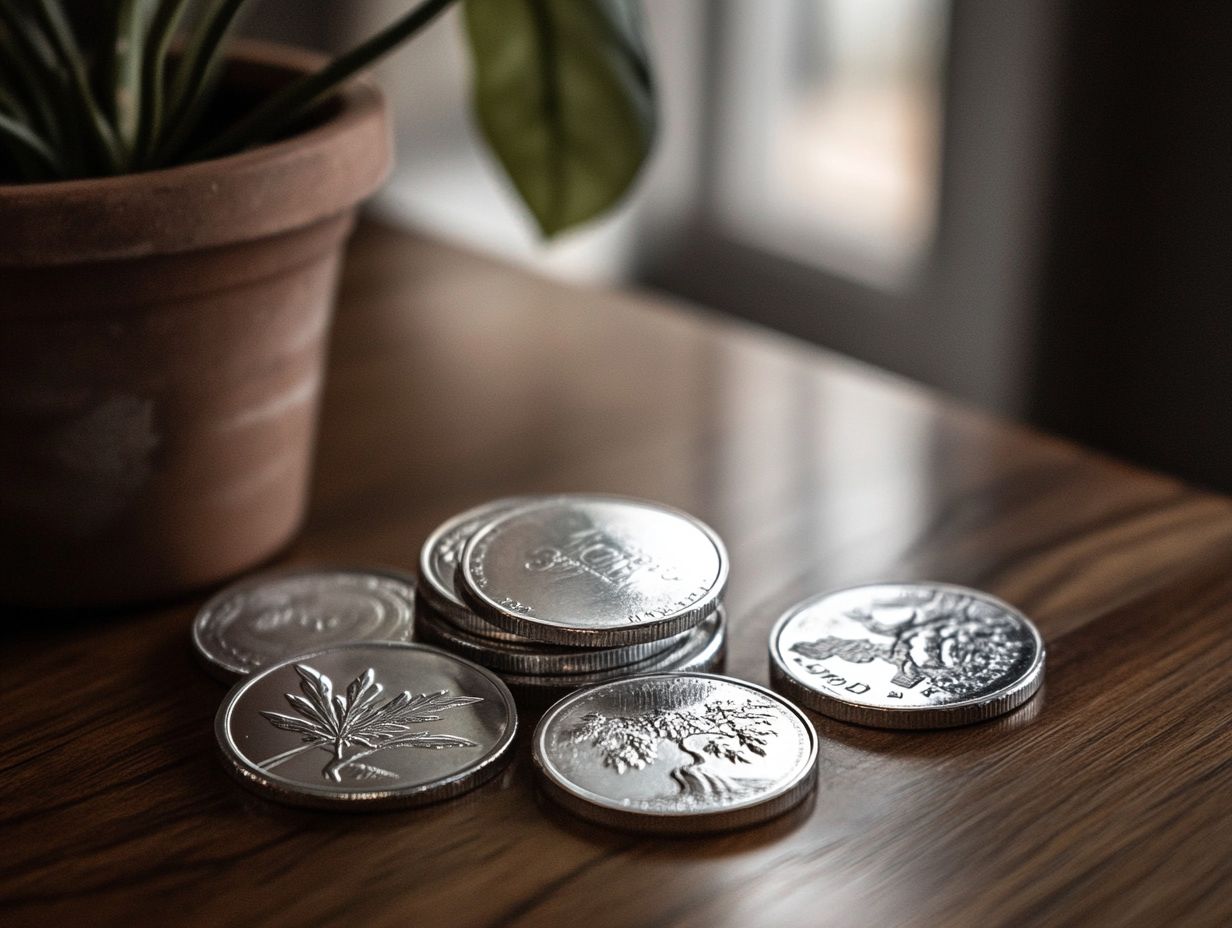
- Diversify your investment portfolio by adding silver to reduce risk and boost growth potential.
- Silver helps protect your investments from the devaluation of currency over time.
- Pay attention to market trends and timing to maximize your silver investment returns.
What is Silver Investing?
Silver investing means buying silver to increase its value and diversify your investments.
It has been a trusted asset during market ups and downs, especially in times of uncertainty.
What makes silver special is its mix of practical use and investment potential.
Unlike stocks or bonds, silver s value holds steady during economic downturns.
This dual benefit makes silver appealing for cautious investors.
Owning silver coins can offer reassurance during challenging times, providing a sense of security.
Benefits of Investing in Silver
Investing in silver offers many advantages. It acts as a safe place for your money and provides chances for growth.
With expanding industrial uses, understanding silver’s benefits is key for diversifying your investments.
Diversification in Portfolio
Diversifying your portfolio is crucial for reducing risk and improving returns.
Including silver can significantly boost your strategy. It not only tends to appreciate in value but also provides a buffer against unstable markets.
If you want to protect your investments from inflation, silver is an effective choice.
A well-diversified portfolio with silver enhances stability and helps you navigate market challenges.
Hedge Against Inflation
Investing in silver acts as a dependable hedge against inflation. It’s an astute choice for anyone looking to safeguard their wealth during times of rising prices.
Historically, silver has maintained its value and often appreciated when inflation rates soar. This offers protection against the diminishing purchasing power of currency, especially during economic downturns and market volatility.
Periods of high inflation frequently accompany economic uncertainty. This prompts a rush toward tangible assets like silver.
This precious metal serves as more than just a store of value; it attracts investors seeking stability when traditional markets become unpredictable.
Many experts highlight past inflationary episodes in which silver has outperformed other assets. They emphasize its role as a protective investment.
As inflationary pressures mount, those who recognize silver’s historical resilience find it an enticing option to enhance their financial security. This is particularly important when navigating turbulent markets.
Types of Silver Investments
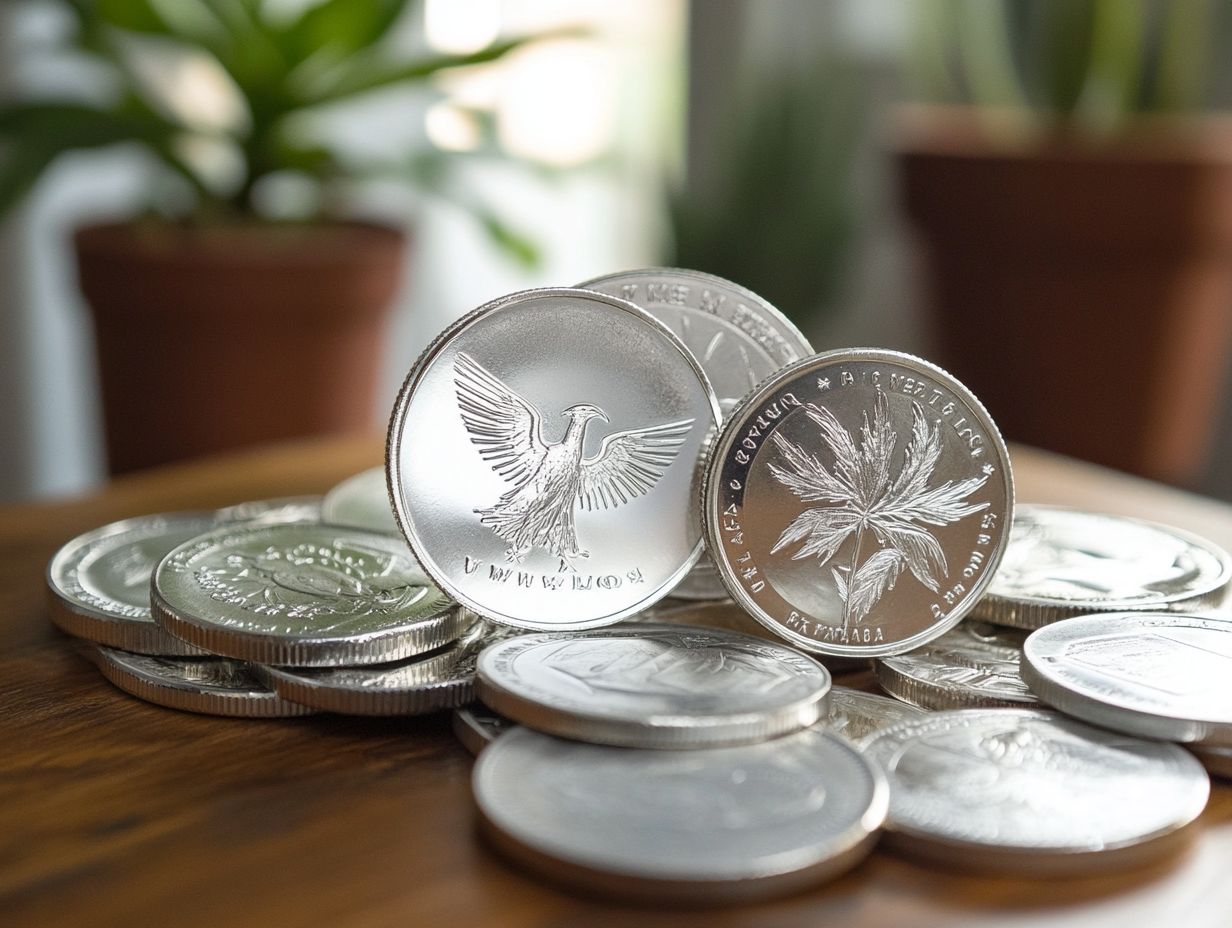
You have a range of silver investment options, each presenting distinct benefits and risks. Traditional avenues, such as acquiring physical silver in the form of coins and bullion, are well-established choices.
Silver ETFs (Exchange-Traded Funds) provide a liquid way to invest in this precious metal. Understanding the details of these options such as the characteristics of sovereign silver and the distinctions between physical and electronic forms is crucial for making informed investment decisions.
Physical Silver
Physical silver encompasses tangible assets like silver coins and bullion. This makes it an appealing choice for investors seeking an affordable investment avenue.
You might be drawn to iconic options like American Eagle coins or Britannia coins, thanks to their recognized value and liquidity. This ensures that you can easily trade or sell them in the financial markets whenever the need arises.
Investing in silver offers easy cash conversion when needed, especially beneficial during economic uncertainty.
However, be aware of potential drawbacks such as storage concerns and the risk of market fluctuations impacting value.
As you explore the variety of coins and bars available, you may find that some offer greater premiums or enhanced resale potential.
By understanding both the pros and cons, you can make informed decisions about incorporating physical silver into your investment portfolio. This ensures it aligns with your financial goals.
Silver ETFs and Stocks
Silver ETFs and stocks offer a contemporary path to investing in silver. They enable you to gain exposure without the hassle of purchasing physical metals.
These financial instruments closely track silver prices and can be traded seamlessly in the financial markets. This provides you with liquidity and flexibility while minimizing the risks associated with storing physical silver.
You ll appreciate the convenience that silver ETFs offer. They grant you straightforward access to silver investment without the burdens of storage and insurance related to physical assets.
You stand to benefit from the potential for higher returns during market upswings, as these assets can react swiftly to market volatility.
However, keep in mind that silver stocks may be influenced by broader market fluctuations. Not all ETFs accurately reflect silver prices.
Understanding these complexities is essential for effectively navigating the pros and cons of these investment vehicles.
Factors to Consider Before Investing in Silver
Before you invest, make sure to consider these key factors to make a well-informed decision.
Market trends and the demand for silver play a significant role in shaping its price movements. Grasping these dynamics is crucial for navigating the intricacies of silver investing.
Geopolitical risks and economic factors can also sway the silver market. Staying informed and ready to adapt your strategies is vital for achieving your investment goals.
Market Trends and Demand
Market trends and demand influence silver’s price in the financial markets. Understanding these factors is essential for investors.
Silver often dances to the rhythm of gold, with the silver to gold ratio helping investors compare the value of silver to gold to make informed decisions.
As you navigate these precious metals, grasping the interplay between market sentiment, economic indicators, and global events that affect markets becomes invaluable. During times of economic uncertainty, the demand for silver tends to rise, often leading to price surges.
Smart investors track changes in the silver to gold ratio. This helps them find new opportunities and align their portfolios with the evolving market.
Stay alert to these market trends. This will help you seize advantageous price movements and enhance your investment outcomes.
Storage and Security
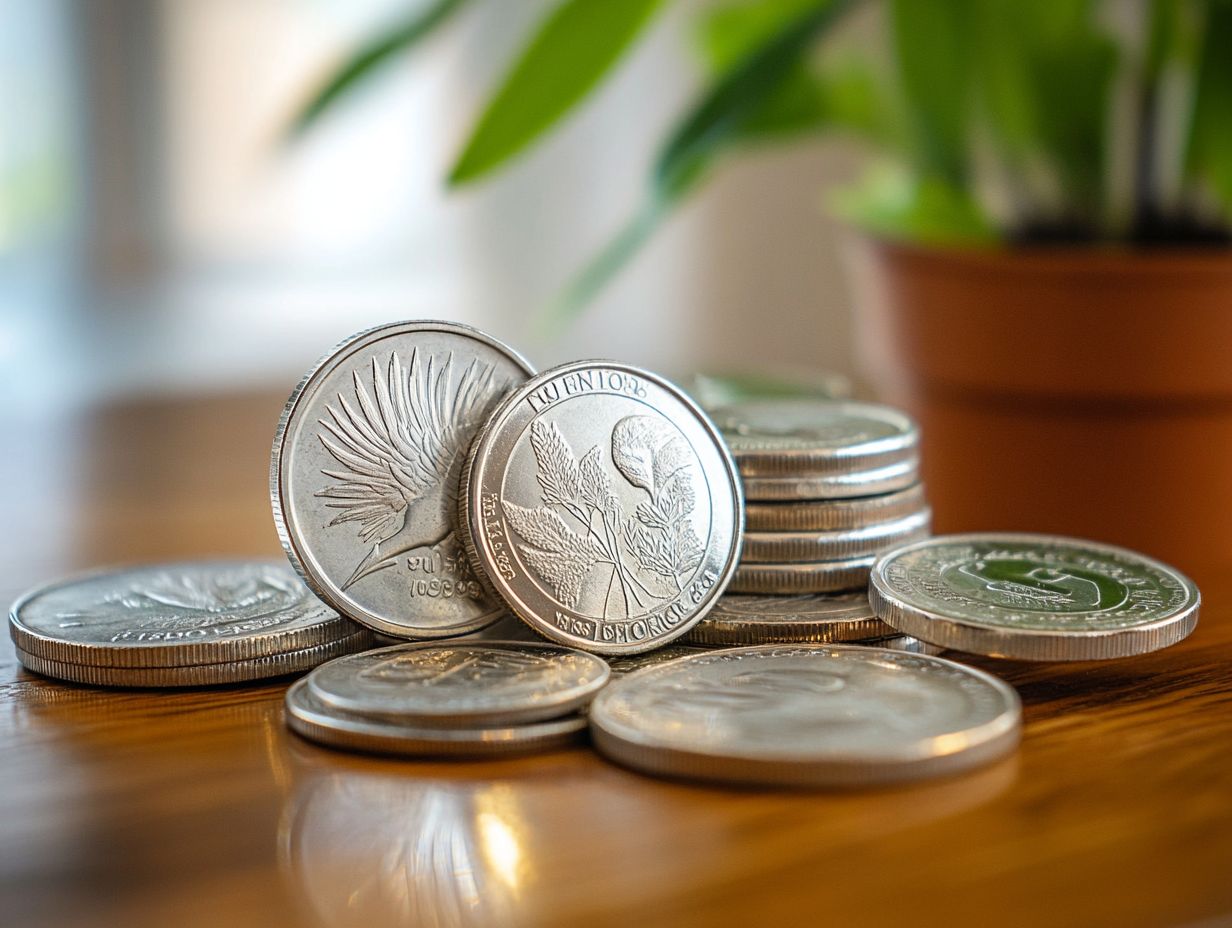
When you invest in silver, ensuring proper storage and security of your physical assets is essential to protect your investment from theft or loss. Options like safe deposit boxes, home safes, and authorized storage facilities are crucial for safeguarding your silver coins and bullion.
Many investment strategies highlight the importance of diversifying your storage locations to mitigate risk. Assess your security measures, including alarm systems and fireproof containers, to bolster protection against unforeseen circumstances.
Engaging third-party custodial services can offer an extra layer of security. These specialized facilities typically feature advanced surveillance systems and comprehensive insurance coverage.
Understanding the various methods available equips you to secure your silver investments effectively. This allows you to concentrate on building your wealth without unnecessary concerns about your stored precious metals.
Maximizing Returns from Silver Investments
Maximizing returns from your silver investments requires a blend of strategic planning and a keen grasp of market dynamics. This enables you to optimize your portfolio effectively.
Act now to time the market and allocate funds wisely. This can significantly boost your returns amid the ever-changing landscape of silver and other precious metals.
Timing the Market
Timing the market is crucial for investors aiming to capitalize on the volatile price movements within the silver market. By grasping market signals and historical trends, you can pinpoint optimal entry and exit points to maximize returns.
This strategic approach requires monitoring various factors, including global economic indicators, interest rates, and geopolitical events that can sway silver demand. During inflationary periods, silver shines as a safe-haven asset, prompting investors to act swiftly to secure better prices.
Utilizing technical analysis such as tracking moving averages and support levels can offer valuable insights into potential market reversals or breakout points. By staying informed and employing these strategies, you can effectively navigate the complexities of investing in silver and seize the opportunities presented by market fluctuations.
Strategic Allocation of Funds
Strategic allocation of funds is essential in any investment portfolio, particularly when integrating silver investments focused on increasing the value of your investment. By distributing your funds across various types of investments and determining the right percentage to allocate to silver, you can optimize your returns while minimizing risks linked to market fluctuations.
Such an approach helps you create a personalized investment strategy that aligns with your financial aspirations. Understanding how the history of silver as an investment fits into your portfolio is crucial, especially if you’re aiming for specific goals such as retirement or wealth preservation.
Incorporating silver not only serves as a hedge against inflation but also enriches your investment landscape. By evaluating both your personal financial situation and current market conditions, you can make informed decisions about how much capital to dedicate to the role of silver in a diversified portfolio, positioning yourself for long-term growth while effectively managing potential volatility within your overall investment portfolio.
Frequently Asked Questions
What are the Benefits of Investing in Silver?
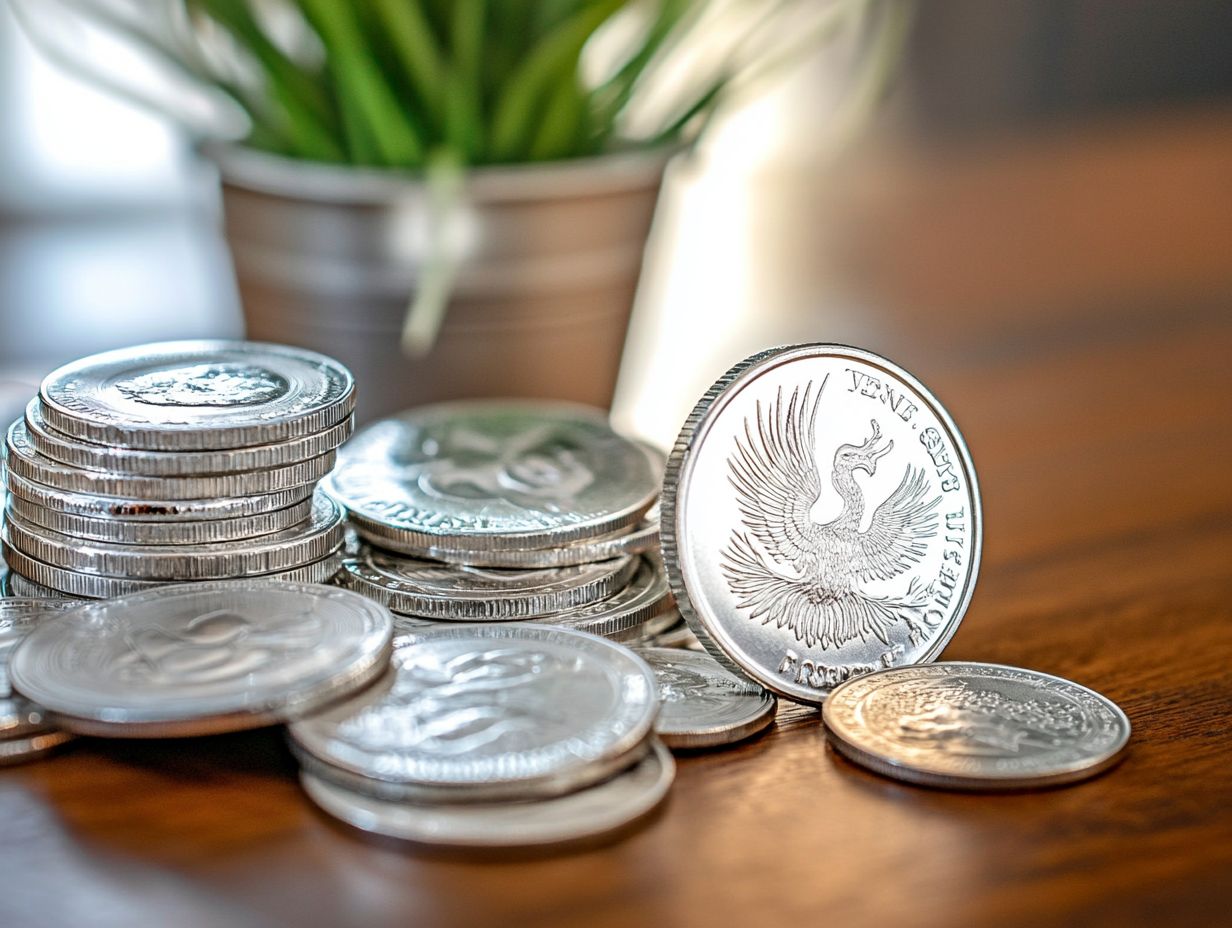
Investing in silver can provide a variety of benefits, including:
- Hedge against inflation
- Portfolio diversification
- Potential for long-term growth
What are the potential returns on investing in silver?
The potential returns on investing in silver can vary, but historically, silver has shown strong returns over time. In the last 10 years, silver has averaged an annual return of over 9%.
How does investing in silver diversify my portfolio?
Silver is considered a precious metal and is often seen as a hedge against inflation and economic uncertainty. By adding silver to your portfolio, you can diversify your investments and potentially mitigate risk.
Are there any tax advantages to investing in silver?
Yes, there are potential tax advantages to investing in silver, such as the ability to defer capital gains taxes until you sell your silver investments.
What are the different ways to invest in silver?
There are several ways to invest in silver, including buying physical silver in the form of coins or bars, investing in silver exchange-traded funds (ETFs), or purchasing shares of silver mining companies.
What are the factors that can affect the price of silver?
The price of silver can be influenced by a variety of factors, such as supply and demand, economic and political conditions, and changes in currency values. It can also be affected by industrial demand, as silver is used in many electronic and medical applications.
If you’re interested in exploring silver investment options, consider consulting a financial advisor for personalized guidance.











